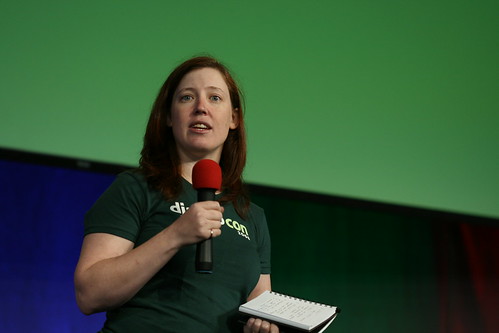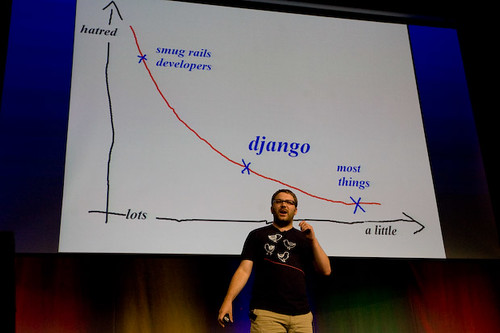This was roughly my bike route today to get to a meeting in Redwood City and back. Apparently about 17 miles, on top of my 6 mile bike between home and the office.
View Larger Map
Tuesday, September 30, 2008
One of the best articles on DRM I've read in a while appears on Penny Arcade, and contains the words "DRM takes a big poo on your best customers". Actually, the full sentence is worth including:
Yeah, that's right, punish your friends and give everything away to your enemies. As artists and creators, you do deserve to make money. Perhaps there are other ways than punitive DRM, however.
I'm not into protesting games that use DRM for protest's sake, although I did avoid buying Spore because of its license checking. I just happen to like games that I can play when I like and pay for when I like. I've given money to Puzzle Pirates, which the author of the article is associated with, because the game let me have fun first before paying. Ikariam is similar but taunted me too much with the for-pay goodies so I found that pressure off-putting. Kingdom of Loathing has the best laid-back attitude towards paying and playing. Not only can I take a break without getting punished, they treat my contributions as valued donations, so I feel good when I toss them some meat.
DRM takes a big poo on your best customers -- the ones who've given you money -- whilst doing nothing practical to prevent others from 'stealing' your precious content juices.
Yeah, that's right, punish your friends and give everything away to your enemies. As artists and creators, you do deserve to make money. Perhaps there are other ways than punitive DRM, however.
I'm not into protesting games that use DRM for protest's sake, although I did avoid buying Spore because of its license checking. I just happen to like games that I can play when I like and pay for when I like. I've given money to Puzzle Pirates, which the author of the article is associated with, because the game let me have fun first before paying. Ikariam is similar but taunted me too much with the for-pay goodies so I found that pressure off-putting. Kingdom of Loathing has the best laid-back attitude towards paying and playing. Not only can I take a break without getting punished, they treat my contributions as valued donations, so I feel good when I toss them some meat.
Thursday, September 25, 2008
I've been asked a lot about use of SOAP in IETF standards. Most of the time, I think it's overkill and poor for interoperability, because it has a bunch of features that probably aren't needed, and if they are used, will not work unless everybody uses them the same way.
While using HTTP directly suffers from the same problem, at least the problem is not doubled by using SOAP over HTTP. And HTTP benefits from fantastic tool support and connectivity. So without further debate about whether HTTP itself is a bad or a good thing to use, here's how to use it in a standard.
---
Ok, I wrote this quickly to get it out and I'd love feedback. There are probably other recipes; this is the one I use. Exceptions exist. Void where prohibited.
While using HTTP directly suffers from the same problem, at least the problem is not doubled by using SOAP over HTTP. And HTTP benefits from fantastic tool support and connectivity. So without further debate about whether HTTP itself is a bad or a good thing to use, here's how to use it in a standard.
- Define your objects, these will be HTTP resources. These are the objects people operate on. In Atom, these objects are entries, feeds and service documents. In CalDAV, objects are calendars and events. In a protocol for transferring karma between people, resources might represent individual karma accounts.
If you can't think of objects but only of services, you may still be able to use HTTP POST to send requests to the service handler and get a response. I guess you're treating your service handler as a kind of object but it's only minimally RESTful to do this. - Don't bother defining the URLs to resources. They'll be HTTP URLs of some kind. Let servers choose and clients discover.
- Define operations on your objects/resources. To create a new one, you should be using PUT (if the client can reasonably construct a new URL that the server will find acceptable) or POST if the server will pick a URL. To remove an object, use HTTP DELETE. To update an object by replacing its content, use PUT.
Some commonoperations are defined in other HTTP extensions already. To update an object by making a change to it, use PATCH. To move or copy an object, use MOVE or COPY. - Define how clients will find resources. E.g. Atom has service documents which locate feeds, and feed documents which locate blog entries. Because of Atom's strongly document-oriented approach, this means Atom uses GET requests for navigation and resource discover. CalDAV, by contrast, uses WebDAV collections for containers, therefore uses PROPFIND for the same purpose.
You may find in this part of the exercise that you've invented new objects to help navigation and resource discovery work well. Reexamine your object model. - If you need permissions, use the WebDAV ACL model if possible. Hold your nose if you need to. It's better than building one yourself. Leave permissions out entirely if you can wait a revision.
- Figure out if you've got any magic or use cases that aren't handled. E.g. CalDAV needed some magic to query calendars to find out "what events occur or reoccur this week". That wasn't solved with a RESTful PROPFIND request, so CalDAV defined some magic and used the REPORT method to carry the request for magic. Define your own new method for this one if you're dying to exert some creativity.
- Figure out the details. There are a fair amount. For example, define whether resources have fixed MIME types; whether caching is appropriate, whether ETags are required. It's probably a good exercise to walk through the section headings of the entire HTTP spec and say "Is this required to support, required not to use, or does it interact with our new protocol in some funny way."
---
Ok, I wrote this quickly to get it out and I'd love feedback. There are probably other recipes; this is the one I use. Exceptions exist. Void where prohibited.
Monday, September 08, 2008

DjangoCon 1.0 was great, and now I've got the T-shirt, as shown at left (one of 100 printed -- in a real female size, no less, thanks to Leah.) The photo is from my lightning talk wherein I introduced myself and gave 10 reasons why people who use Django might be interested in IETF and how I could help. Also I'm tickled because the photo was taken by Simon Willison, whose blog I've been reading ever since I started using Django.
It's always nice to meet people with common interests, people I've gotten some awareness of online, but it was especially lovely this time.
 As Cal Henderson (shown left, pic by webmonkey_photos on flickr) pretty much said in the funny roast-style keynote entitled "Why I Hate Django", the core Django people are just too damn nice.
As Cal Henderson (shown left, pic by webmonkey_photos on flickr) pretty much said in the funny roast-style keynote entitled "Why I Hate Django", the core Django people are just too damn nice. I also had moment after moment of future shock, just thinking about how many more tools we have for self-organizing as groups of people. Blogs, forums, voting widgets, comment fields, shared calendars and shared docs, collaborative bookmarking and tagging. Yes, none of these are new to Django but Django makes sites with these features very easy to create. I got started on dial-in text-only bulletin boards, people -- we're talking 28 kb modem -- consciously moving my reference point further back than it normally is. And on the other side of the coin, Django is such a useful project because of the online collaboration of loosely connected individuals. That's some heavy bootstrapping there.
Subscribe to:
Posts (Atom)
